Enrique Morente facts for kids
Quick facts for kids
Enrique Morente
|
|
|---|---|
 |
|
| Background information | |
| Birth name | Enrique Morente Cotelo |
| Born | 25 December 1942 Granada, Spain |
| Died | 13 December 2010 (aged 67) Madrid, Spain |
| Genres | New flamenco |
| Occupation(s) | Singer, songwriter |
| Years active | 1960s–2010 |
Enrique Morente Cotelo (born December 25, 1942 – died December 13, 2010), known as Enrique Morente, was a famous flamenco singer from Spain. He was a very important person in modern flamenco music.
Enrique Morente started by singing traditional flamenco. But then he began to experiment. He created new tunes for cante (flamenco singing). He also played music with artists from many different styles. Even with all his new ideas, he always remembered his flamenco roots. He kept singing traditional flamenco too.
Some people criticized him for trying new things. But he became one of the most important flamenco singers of his time. He didn't just innovate; he also created new traditions. Other famous flamenco singers have performed his songs. These include Camarón de la Isla and Estrella Morente, who is his daughter. A book of poems by Leonard Cohen, called The Flame, even includes a poem honoring Morente.
Contents
About Enrique Morente
Enrique Morente was born in a traditional part of Granada, Spain. As a child, he sang as a seise. This was a group of children who sang and danced for religious festivals. He loved flamenco singing from a young age. He learned a lot by listening to people sing at family gatherings. He also learned from famous flamenco singers in Granada.
Morente believed that flamenco artists need skill and hard work. He said it's a profession, just like any other. Artists need to dedicate themselves completely to it.
When he was a teenager, Morente moved to Madrid. He wanted to become a professional singer. There, he met old flamenco masters. He learned as much as he could from them. One master, Pepe de la Matrona, took a special interest in him.
In Madrid, Morente began singing in flamenco clubs called peñas flamencas. In 1964, he signed a contract with a dance group. He performed with them at the 1964 World's Fair in New York. He also sang at the Spanish Embassy in Washington D.C. Later, he toured Europe and Japan with flamenco dance groups. He also worked in several tablaos (flamenco venues) in Madrid.
First Songs and Albums
Morente made his first recording in 1967. It was called Cante flamenco. He worked with guitarist Félix de Utrera. This album won a special award. His next album, Cantes antiguos del flamenco (1969), showed his deep knowledge of traditional flamenco. This was rare for singers his age.
Around this time, he also started working with guitarist Manolo Sanlúcar. Sanlúcar played with him at a concert in Ateneo de Madrid. This was the first time a flamenco singer performed in that important cultural place.
His album Homenaje flamenco a Miguel Hernández (1971) was special. It was the first time he used lyrics by famous poets. Later, he would sing flamenco songs using poems by Federico García Lorca, John of the Cross, and others. He cared a lot about the words in his songs. This was a big step in his journey to innovate flamenco. His songs, like "Nana de la Cebolla," became very famous. They also showed his feelings against the government at the time. This made him a favorite singer for many people.
In 1971 and 1972, he toured Mexico and New York City. In 1972, he received the Premio Nacional del Cante (National Award for Flamenco Singing).
Mixing Old and New Styles
Morente returned to traditional flamenco with his album Homenaje a Don Antonio Chacón (1977). This album won a National Award for best folk music. In it, Morente honored singer Antonio Chacón. Chacón was a key figure in flamenco from the early 1900s.
But Morente loved to mix tradition with new ideas. So, right after that album, he released Despegando ("Taking off") in 1978. This album was very innovative, just like its title suggested.
In 1981, he toured with a new show called Andalucía hoy ("Andalusia Today"). He performed this show at the famous Paris Olympia in France. In 1982, some of his recordings were chosen for a big flamenco collection. This collection showed many traditional flamenco styles.
In 1990, he went back to traditional flamenco again. He recorded Morente-Sabicas with the legendary guitarist Sabicas. The next year, he created a flamenco mass. This was a new kind of flamenco music. Morente's mass mixed flamenco with other styles, like Gregorian chant.
Later Music and Collaborations
In 1995, Enrique Morente appeared in Carlos Saura's film Flamenco. He also recorded his most talked-about album, Omega. On this album, he worked with the rock band Lagartija Nick. They mixed flamenco with punk rock. They also used songs by Leonard Cohen and poems by Federico García Lorca. This album was performed live at a big music festival in 2008.
In 2001, a special album by Morente was released. It was called "Enrique Morente en la Casa Museo de García Lorca de Fuentevaqueros." This album featured songs based on Federico García Lorca's poetry. It was a limited edition and very hard to find.
Another interesting album, El Pequeño Reloj, came out in 2003. The first part of this album was unique. Morente's voice was added on top of old recordings of flamenco guitar masters. The second part then developed the same music with a modern guitarist.
Even though Morente could not read musical notation, he composed music. He wrote music for plays, movies, and TV shows. He also mixed flamenco with classical music. He performed with the Madrid Symphony Orchestra. He also worked with the Bulgarian Voices choir Angelite.
Morente loved to mix flamenco with music from other cultures. He collaborated with music from Senegal and Cuba. He said that Cuban music has always been close to flamenco. This is because ships from Cádiz often traveled to Cuba. Morente was interested in all kinds of music.
Because of his new ideas, some traditional flamenco fans criticized Morente. They felt he was changing flamenco too much. But today, most critics and fans recognize his amazing talent. They see his deep artistic intelligence and dedication. He took the traditional foundations of flamenco and built something new and powerful.
Enrique Morente passed away in Madrid on December 13, 2010.
Awards and Honors
- First prize at the Málaga Cantaora contest (1967)
- National Award for Flamenco Singing (1972)
- National Award for best folk recording (1978)
- Honorary Membership of the San Juan Evangelista Jazz and Music Club (1989)
- Premio Nacional de Música (Music National Award) (1994)
- Golden medal of the Cátedra de Flamencología de Jerez de la Frontera (1995)
- Compás del Cante (1995)
- “Galardón de Honor de los Premios de la Música" (1998)
- Pastora Pavón ("Niña de los Peines") Award (2004)
- Medal of Andalusia (2005)
- National Critics award for best DVD and best flamenco singing record for Morente sueña la Alhambra (2006)
- National Award of Music for best flamenco recording for Morente sueña la Alhambra (2006)
- Morato de Oro (2006)
- Best flamenco recording, Deflamenco.com Awards (2006)
Films About Enrique Morente
- Flamenco. Directed by Carlos Saura (1995)
- Morente sueña La Alhambra. Directed by José Sánchez-Montes (2005)
- Iberia. Directed by Carlos Saura (2005)
- Morente. Directed by Emilio R. Barrachina (2011)
Discography (Albums)
- Cante flamenco (1967)
- Cantes antiguos del flamenco (1969)
- Homenaje flamenco a Miguel Hernández (1971)
- Se hace camino al andar (1975)
- Homenaje a Don Antonio Chacón (1977)
- Despegando (1977)
- Morente en vivo (1981)
- Sacromonte (1982)
- Cruz y Luna (1983)
- Esencias flamencas (1988)
- Morente – Sabicas (1990)
- Enrique Morente en la Casa Museo de Federico García Lorca de Fuentevaqueros (1990)
- Misa flamenca (1991)
- Negra, si tú supieras (1992)
- Alegro, Soleá y Fantasía del Cante Jondo (1995)
- Omega (1996)
- Morente – Lorca (1998)
- El pequeño reloj (2003)
- Morente sueña la Alhambra (2005, Mute Records)
- Pablo de Málaga (2008)
See also
 In Spanish: Enrique Morente para niños
In Spanish: Enrique Morente para niños


